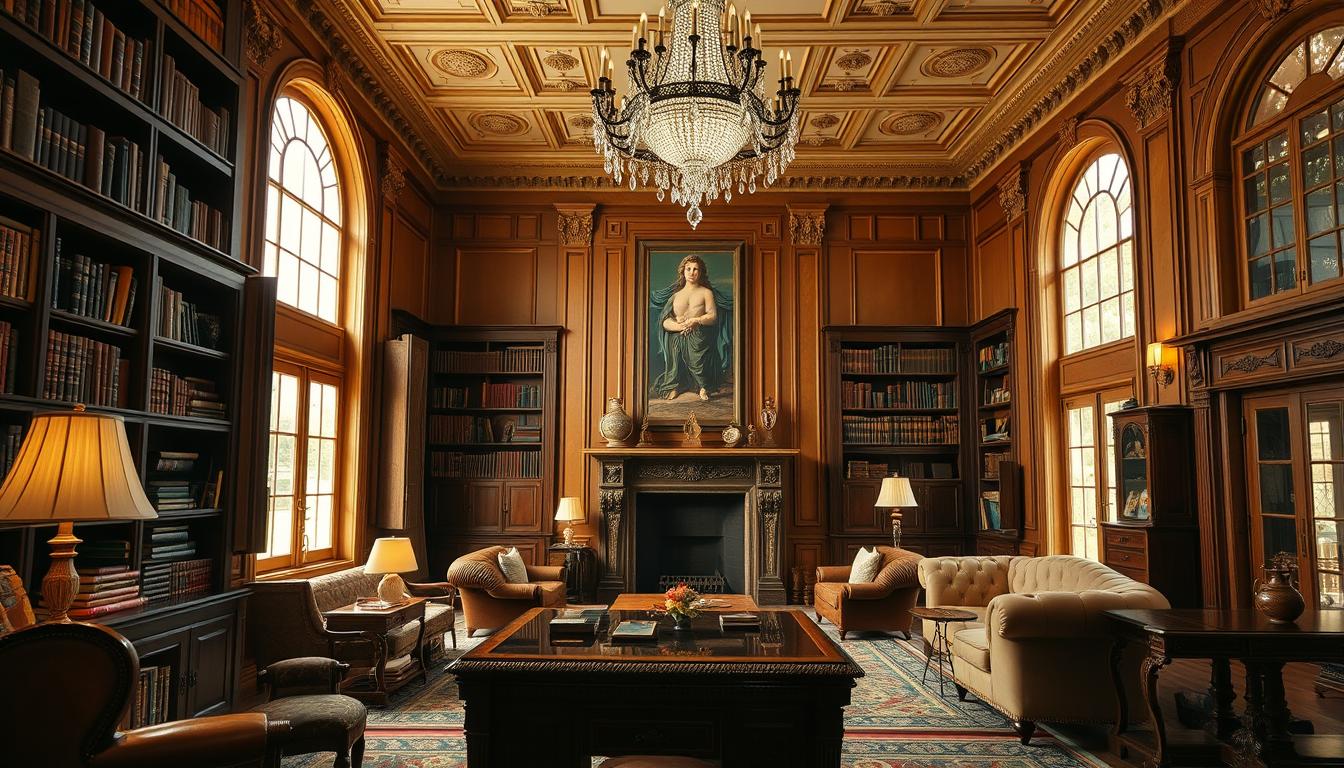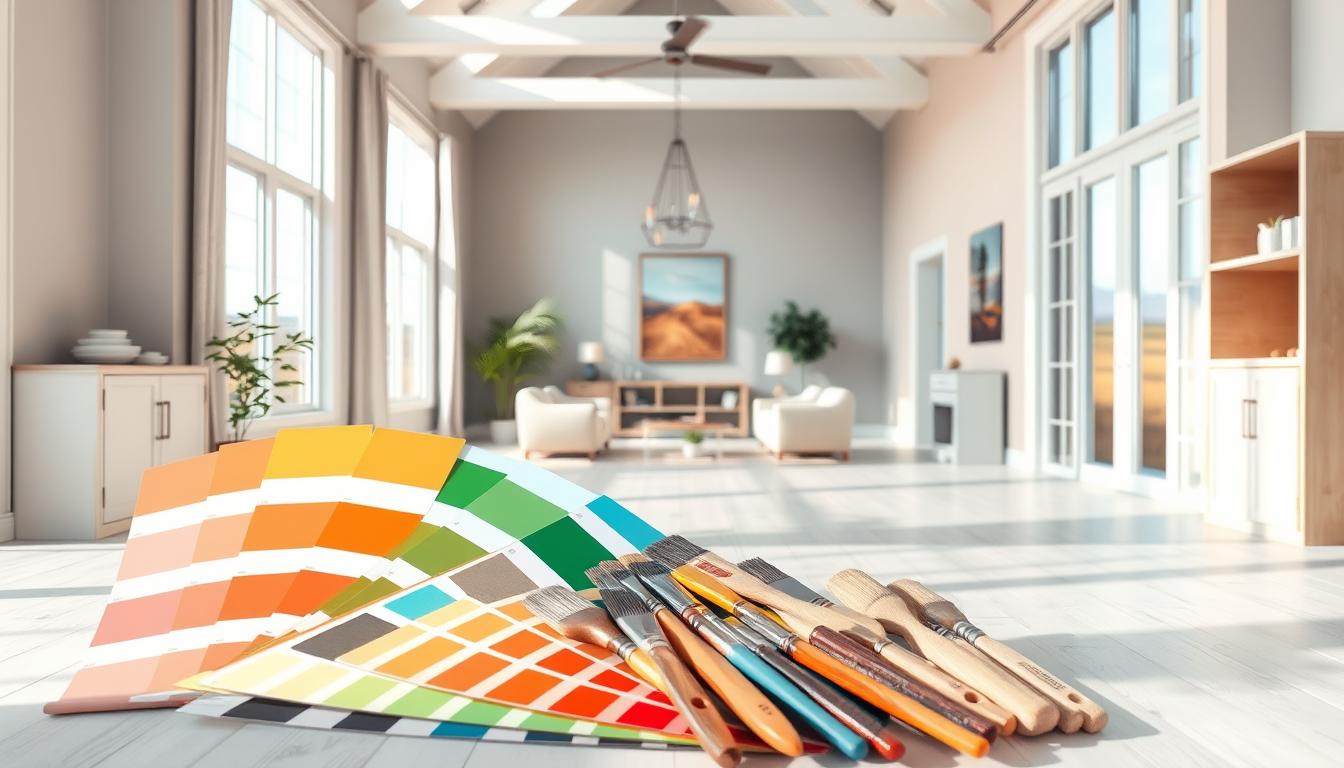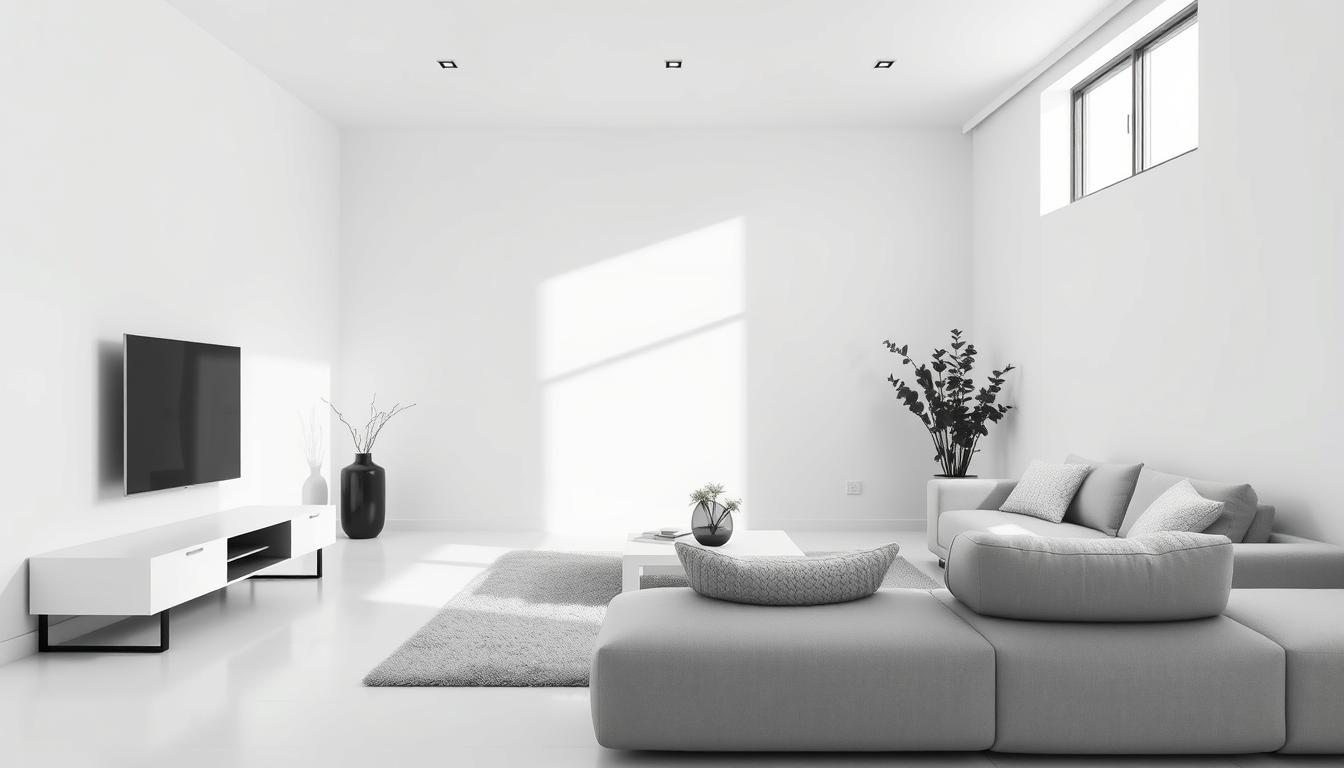Did you know the colonial style is inspired by 18th-century American architecture? It’s still very popular in the United States. Mixing traditional elements with modern touches can make a colonial home design truly stand out.
Exploring colonial interiors, we’ll look at its history and design principles. Knowing what makes colonial design special helps us mix old and new. This way, we can create an interior that honors the past while feeling modern.
Key Takeaways
- Understanding the historical context of colonial design
- Key elements that define a colonial-style interior
- Tips for incorporating modern elements into a colonial design
- Choosing the right color palette for a colonial home
- Selecting furniture that complements a colonial aesthetic
Understanding the Colonial Home Aesthetic
To grasp the colonial home aesthetic, we must explore its historical roots. It reflects the architectural styles of early European settlers in America. This style has a classic appeal that stands the test of time.
Key Characteristics of Colonial Style are seen in its architecture. Colonial Revival homes, for example, have symmetrical structures and evenly spaced windows. They also have a central door and classical details like pilasters and pediments. These features add to the timeless elegance of colonial homes.
Key Characteristics of Colonial Style
The colonial style is known for several architectural features. These include:
- Symmetrical facades
- Evenly spaced windows
- Central front door, often with a decorative crown or pediment
- Multi-paned double-hung windows
- Gabled roofs, sometimes with dormer windows
These features shape both the exterior and interior of colonial homes. They create a cohesive and harmonious look.
Historical Context of Colonial Design
The colonial style comes from America’s early history. European settlers brought their architectural traditions to the New World. Over time, these traditions evolved into a unique style that met the colonists’ needs.
The Colonial Revival period, from the late 19th to the early 20th century, saw a renewed interest in these designs. This revival celebrated the simplicity, symmetry, and classical elements of colonial architecture.
Knowing the historical context is key to understanding colonial style decor and traditional interiors. It helps homeowners and designers incorporate these elements authentically into modern homes.
Color Palettes for Colonial Interiors
Choosing the right colors is key when designing a colonial home interior. The colors set the mood for the whole space. They bring out the classic charm and warmth of colonial homes.
Colonial interiors are known for their calm, neutral tones. These colors are timeless and perfect for adding modern touches.
Traditional Color Schemes
Traditional colonial colors include soft peaches, blues, and other muted shades. These colors match well with the natural materials found in colonial homes, like wood.
- Soft Neutrals: Beige, cream, and soft gray are common in colonial interiors. They make a clean background for furniture and decor.
- Muted Earth Tones: Colors like terracotta, sienna, and moss green reflect the natural world.
- Rich Blues and Greens: Deep blues and greens add depth and elegance to rooms.
Modern Takes on Colonial Colors
Modern interpretations of colonial interiors mix new colors and textures. This creates a fresh yet classic look.
- Bold Accent Colors: A bold accent color can modernize a colonial interior. Try deep reds, navy blues, or vibrant yellows.
- Metallic Accents: Adding metallic accents like brass, copper, or silver adds sophistication.
- Layered Textures: Combining different textures, like velvet, linen, and wood, adds depth and interest.
By blending traditional colors with modern elements, you can make a colonial interior feel both authentic and contemporary.
Flooring Choices in Colonial Homes
The flooring in colonial homes greatly affects the feel and look of the interior. It’s not just about function; it’s also key to achieving the traditional look homeowners want.
Popular Flooring Materials
In colonial home design, some flooring materials stand out more than others. Hardwood flooring is a favorite, with oak, maple, and pine being top choices. These woods are strong and timeless, fitting perfectly with the colonial style.
Brick and stone were also used back then, though less for floors. They were often seen in entryways or fireplaces. Today, they’re used in some homes to bring in a historical feel.
- Hardwood: Offers durability and a classic look.
- Brick and stone: Used for added authenticity and texture.
- Engineered Wood: A cost-effective alternative to solid hardwood.
The Role of Area Rugs in Design
Area rugs are crucial in colonial interiors for both design and comfort. They bring warmth, texture, and color, making rooms feel cozier. In colonial homes, rugs helped define spaces and warm up hardwood floors.
When picking area rugs for a colonial home, choose designs that match the colonial look. Persian and Savannah patterns are great, adding elegance and sophistication.
- Choose rugs with traditional patterns.
- Consider the color palette of your flooring and walls.
- Layer rugs for added depth and warmth.
Furniture Selection for Colonial Spaces
To make a colonial home look stunning, picking the right furniture is key. Furniture shapes the look and feel of a colonial-style home. We’ll look at how to choose furniture that’s true to the colonial era but also has today’s comforts.
Selecting Authentic Colonial Furniture
Real colonial furniture is known for being simple, strong, and well-made. When choosing colonial-style furniture, look for solid woods like oak, maple, or cherry. The build should be solid, showing off the era’s craftsmanship.
Items like four-poster beds, Queen Anne chairs, and classic wooden chests are key to colonial decor. They add history and warmth to your home.
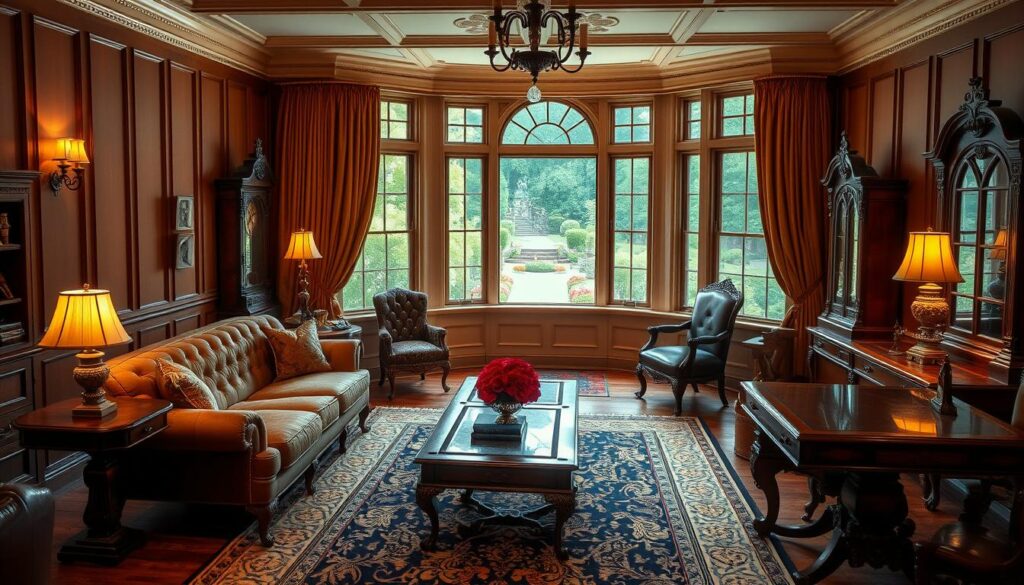
How to Incorporate Modern Pieces
While traditional furniture is essential, adding modern pieces can make your home more functional and comfy. Modern furniture can include upholstered sofas, contemporary lighting fixtures, or innovative storage solutions. The trick is to mix modern with traditional colonial pieces.
For example, combining a classic wooden dining table with modern, comfy chairs works well. Adding a modern area rug can also bring in color and texture, improving the look.
Lighting Solutions for Colonial Interiors
The right lighting can make a colonial home feel warm and inviting. It’s key to enhancing these historic homes’ beauty.
Types of Lighting Fixtures
Colonial homes often had traditional lighting that added charm. Some popular choices include:
- Chandeliers: A classic choice for colonial interiors, chandeliers can be a stunning centerpiece in dining rooms or entryways.
- Candles: Candles were historically used in colonial homes and can still be incorporated today for a warm, authentic glow.
- Sconces: Wall-mounted sconces can provide additional lighting and complement the colonial style.
For more inspiration on colonial lighting, you can visit Olde Brick Lighting’s colonial lighting ideas.
Balancing Natural and Artificial Light
Balancing natural and artificial light is key to creating a welcoming atmosphere in colonial interiors. Here are some tips:
- Maximize Natural Light: Ensure that windows are not obstructed to allow natural light to flood the rooms.
- Layer Artificial Light: Use a combination of overhead lighting, table lamps, and floor lamps to create a layered lighting effect.
- Choose Warm Lighting: Opt for warm-toned light bulbs to create a cozy ambiance that complements the colonial style.
By carefully selecting lighting fixtures and balancing natural and artificial light, you can enhance the beauty of your colonial home interior.
Wall Treatments and Decor
The walls of a colonial home are like a canvas, waiting for the right touches. These touches should reflect the classic elegance of this timeless style. Wall treatments are key in defining the look and feel of a room in traditional colonial interiors.
Choosing the right wall treatment is crucial in colonial style decor. For centuries, wallpaper and wainscoting have been favorites in colonial homes. They greatly impact the overall look and feel of your home.
Classic Wallpaper Patterns
Wallpaper has been a staple in colonial style decor for ages. It adds color, texture, and pattern to the walls. Classic patterns like stripes, florals, and damask were favorites, bringing sophistication and elegance to rooms.
Some iconic wallpaper patterns in traditional colonial interiors include:
- Toile de Jouy, known for its intricate designs depicting pastoral scenes
- Striped patterns, which can add a sense of height and grandeur to a room
- Floral motifs, which bring a touch of nature indoors
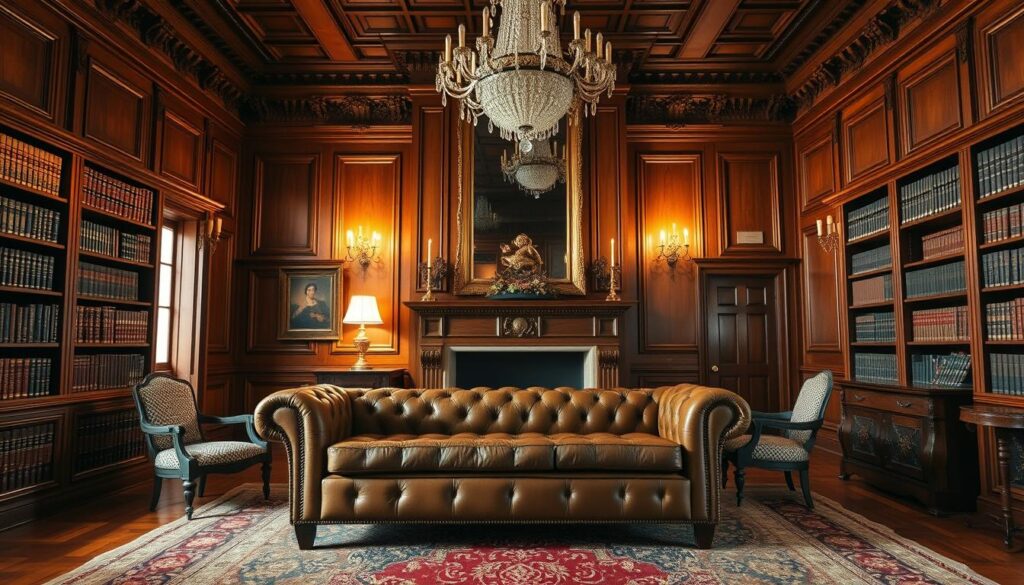
Utilizing Wainscoting and Molding
Wainscoting and molding add depth and visual interest to walls in colonial homes. Wainscoting, usually made from wood, covers the lower wall part. Molding frames doors, windows, and ceiling edges.
Wainscoting and molding not only look good but also create a sense of continuity. They help tie the design together. Here’s how different molding types can be used:
| Type of Molding | Description | Common Use |
|---|---|---|
| Crown Molding | Decorative molding where the wall meets the ceiling | Ceilings, adding elegance |
| Chair Rail | Molding to protect walls from chair backs | Dining rooms, hallways |
| Baseboard | Molding at the wall’s lowest part | All rooms, for a finished look |
By using these classic wall treatments and decor elements, homeowners can create a truly authentic colonial style interior. This style is both beautiful and historically inspired.
Textile Choices in Colonial Design
Colonial interiors are known for their rich, layered look. This is thanks to careful textile choices. The right fabrics and patterns bring warmth and elegance to colonial homes.
Popular Fabrics and Patterns
Natural fabrics like cotton, linen, and wool were key in colonial homes. They were durable and comfortable, connecting us to nature. Patterns like stripes, florals, and geometrics were used in upholstery, curtains, and bedding.
Key Fabrics:
- Cotton: Breathable and versatile, ideal for everyday use.
- Linen: Known for its cooling properties, perfect for warm climates.
- Wool: Warm and durable, often used for upholstery and heavier drapes.
Layering Textiles for Comfort
Layering different textiles adds depth and interest to a room. Start with a base layer, like a cotton sheet or a linen tablecloth. Then add throws, blankets, or embroidered linens.
| Fabric | Use | Benefits |
|---|---|---|
| Cotton | Upholstery, Bedding | Breathable, Soft |
| Linen | Curtains, Tablecloths | Cooling, Durable |
| Wool | Upholstery, Throws | Warm, Resilient |
By choosing and layering textiles wisely, you can make a colonial home interior beautiful and inviting. Think about the historical context and natural materials of the colonial era when making your choices.
Incorporating Art and Accessories
To truly capture the essence of colonial style, it’s essential to thoughtfully incorporate art and accessories. These should reflect the historic charm and elegance of these homes.
When selecting art for your colonial home, consider pieces that echo the period’s aesthetic. This might include landscapes, portraits, or still-life paintings that were popular during the colonial era.
Selecting Art That Complements Colonial Style
Artwork in colonial homes often featured scenes or motifs that were relevant to the time. Consider incorporating:
- Historical prints or engravings
- Traditional landscapes, such as pastoral scenes
- Portraits of family members or historical figures
These types of art not only complement the colonial style but also add a layer of personal history to your home.
Antique vs. Contemporary Accessories
When it comes to accessories, you can choose between antique pieces that reflect the era of your home or contemporary items that pay homage to the colonial style.
| Accessory Type | Antique | Contemporary |
|---|---|---|
| Candlesticks | Brass or silver candlesticks from the 18th century | Reproduction candlesticks with a vintage finish |
| Vases | Antique ceramic or porcelain vases | Contemporary designs inspired by antique patterns |
Both antique and contemporary accessories can enhance your colonial home’s decor. The key is to select items that resonate with the style’s historical context while reflecting your personal taste.
By carefully choosing art and accessories, you can create a cohesive and inviting atmosphere in your colonial home. This atmosphere honors its heritage.
Bringing it All Together
Designing a stunning colonial home interior is all about balance. It’s about mixing functionality with historical charm. Understanding the colonial aesthetic is key to making it feel both real and modern.
Creating Spaces That Work
To make your colonial home functional, think about each room’s purpose. Choose furniture that shows off the colonial style but also feels comfortable. Mixing modern pieces with traditional furniture makes your space both useful and charming.
Maintaining Colonial Charm
To keep the colonial charm alive, focus on details like colors, flooring, and textiles. Stick to traditional colors and classic wallpaper patterns. Adding antique or vintage accessories brings authenticity to your home.
By combining these elements, you can create a colonial home that’s both beautiful and practical. It becomes a perfect mix of past and present.

